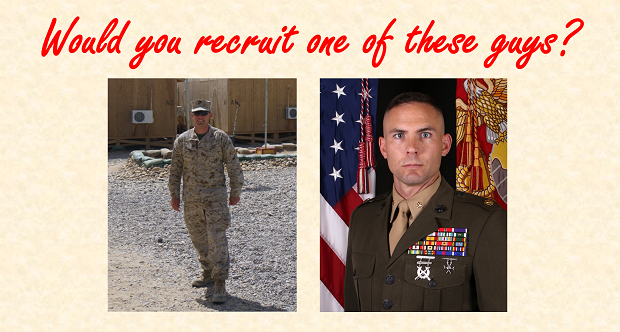
Recruiters, hiring managers, and talent decision makers, when was the last time you reached out to a Transitioning Veteran to introduce yourself, offered to take them to lunch, asked about their professional experiences, or shared about yours? Don’t worry if the answer is never because you would be in good company. And why should you when there are already more talented Veterans coming to you than you know what to do with?
We all get it, time is valuable, and you need to find people with the right set of specific skills that can snap in quickly and add immediate capacity to the team. Most Veterans have done some pretty cool stuff and have proven leadership abilities but they haven’t mastered your software programs, used your CRM, held P&L responsibility for a multi-million dollar balance sheet, and they really don’t understand half of the bullets on any of your job postings. Sure, you’ve interviewed a few because you like the idea of hiring Veterans, but when it comes time to pull the trigger there is always somebody else just a little more qualified. Not to mention you’ve heard cautionary tales about Veteran turnover and you want to avoid being back where you started a year from now. You run a company not a training program. Right?
Right, you do run a business and can’t invest tons of time training people to do their job–on the job–particularly when you have qualified candidates beating down your virtual door.
Or can you? Most companies approach hiring Veteran “generalists” as if they should be industry “specialists” and measure them by how well they can conform to the box of the ideal candidate. A more visionary approach is to take a step back and assess the overall needs and shortfalls of an entire team or organization to determine where the task saturation and spillage occurs. Oftentimes, it is not in the core business functions but rather in the collateral duties employees are assigned or voluntarily take on. From this perspective, a highly adaptive “generalist” with a demonstrated history of learning quickly and working well with others could make an immediate impact without having spent a day in your company or industry. Such a model would actually allow your new “generalist” to learn your lingo, company, and industry while making an immediate impact on the job.
There are many great ways to find and hire Veteran “generalists” and you should keep them all in your generalist finding toolbox. However, leaders and organizations serious about finding the very best fellow leaders to join and grow within their organization, should move to the procedural left of the application process and get to know service members that are 6-12 months away from transitioning to civilian life by initiating contact and just getting to know them and their background. As the network of leaders seeking Veterans approaches the volume of Veterans transitioning, easy referrals between friends and business partners can help both candidates and companies find good matches likely to generate positive immediate, and long-term, success for both the Veterans and the businesses.
But what about these pictures? The two above are of me in Afghanistan in 2011 and in my “service” uniform in 2014, shortly before my retirement. Although neither of these served as my profile picture, many Veterans use similar uniformed pictures on their page with as much or more pride as any professionally done executive headshot.
The court of public (already transitioned veterans and transition advisor) opinions will surely–and rightly–insist that any Veteran still sporting one of these pics immediately and permanently retire it in favor of a kinder, gentler image appealing to even the most “civil” of civilians. This is good advice for all transitioning Veterans, particularly those that want to shift away from the Defense industry.
But what should talent hungry employers make of these pictures?
For one reason or another, we Veterans don’t all get the memo or perhaps we’re too busy to read it, act on it, or even consider the implications… or maybe we just haven’t gotten around to getting a headshot. Whatever the reason, one thing is for certain, you don’t have to look very far on LinkedIn to find active duty service members listing “transitioning” on their profiles while still sporting a service uniform “command photo,” an action shot in their camouflage utility uniform “cammies,” or even physical training “PT” gear.
Savvy executives, recruiters, and hiring managers should all realize that finding the right Veteran with a military picture and the word “transitioning” on the profile is like stumbling upon a great stock tip that you didn’t expect and nobody else knows about. Reach out to that Veteran, say “Hi”, and get to know them and what they are capable of. You won’t regret it.
And the next time you see a military picture pop-up, the first thing that should pop into your mind is “Hire, don’t just admire!”

